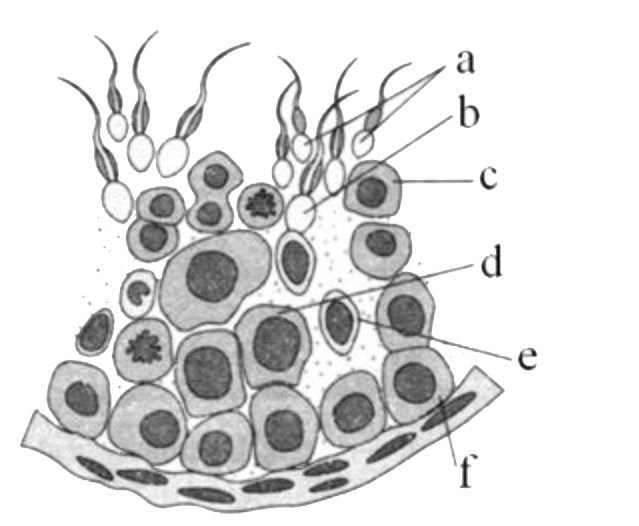Which of the following are haploid in nature?
I. Spermatids
II. Secondary spermatocytes
III. Spermatogonia
IV. Primary spermatocytes
I, II, III, are correct
I and II are correct
II and IV are correct
I and III are correct
The correct Answer is:B
To determine which of the given options are haploid in nature, we will analyze each option based on the process of spermatogenesis.
1. Understanding Spermatogenesis:
- Spermatogenesis is the process of sperm formation that occurs in the testes. It involves several stages of cell division and differentiation.
2. Analyzing Each Option:
- I. Spermatids:
- Spermatids are the result of the second meiotic division of secondary spermatocytes. They are haploid (n) because they have half the number of chromosomes compared to the original diploid cell.
- Conclusion: Spermatids are haploid.
- II. Secondary Spermatocytes:
- Secondary spermatocytes are formed from primary spermatocytes through the first meiotic division. They are also haploid (n) as they have undergone reduction division.
- Conclusion: Secondary spermatocytes are haploid.
- III. Spermatogonia:
- Spermatogonia are the initial germ cells that undergo mitosis to produce primary spermatocytes. They are diploid (2n) because they have the full set of chromosomes.
- Conclusion: Spermatogonia are diploid.
- IV. Primary Spermatocytes:
- Primary spermatocytes are formed from spermatogonia and are also diploid (2n). They undergo meiosis to form secondary spermatocytes.
- Conclusion: Primary spermatocytes are diploid.
3. Final Evaluation:
- From the analysis, we find that:
- Haploid: Spermatids (I) and Secondary Spermatocytes (II)
- Diploid: Spermatogonia (III) and Primary Spermatocytes (IV)
4. Correct Answer:
- The options that are haploid in nature are I (Spermatids) and II (Secondary Spermatocytes).
Final Answer:
The correct options that are haploid in nature are I and II.
- Spermatogenesis is the process of sperm formation that occurs in the testes. It involves several stages of cell division and differentiation.
- I. Spermatids:
- Spermatids are the result of the second meiotic division of secondary spermatocytes. They are haploid (n) because they have half the number of chromosomes compared to the original diploid cell.
- Conclusion: Spermatids are haploid.
- Secondary spermatocytes are formed from primary spermatocytes through the first meiotic division. They are also haploid (n) as they have undergone reduction division.
- Conclusion: Secondary spermatocytes are haploid.
- Spermatogonia are the initial germ cells that undergo mitosis to produce primary spermatocytes. They are diploid (2n) because they have the full set of chromosomes.
- Conclusion: Spermatogonia are diploid.
- Primary spermatocytes are formed from spermatogonia and are also diploid (2n). They undergo meiosis to form secondary spermatocytes.
- Conclusion: Primary spermatocytes are diploid.
- From the analysis, we find that:
- Haploid: Spermatids (I) and Secondary Spermatocytes (II)
- Diploid: Spermatogonia (III) and Primary Spermatocytes (IV)
- The options that are haploid in nature are I (Spermatids) and II (Secondary Spermatocytes).
The correct options that are haploid in nature are I and II.
Topper's Solved these Questions
- BOOK - ICSECHAPTER - HUMAN REPRODUCTIONEXERCISE - COMPETITION CORNER (OBJECTIVE TYPE QUESTIONS (ASSERTION AND REASON TYPE QUESTIONS))9videos
HUMAN REPRODUCTION
- BOOK - ICSECHAPTER - HUMAN REPRODUCTIONEXERCISE - MULTIPLE CHOICE QUESTIONS39videos
HUMAN REPRODUCTION
- BOOK - ICSECHAPTER - HUMAN REPRODUCTIONEXERCISE - REVIEW QUESTIONS16videos
HUMAN REPRODUCTION
- BOOK - ICSECHAPTER - HUMAN HEALTH AND DISEASE EXERCISE - COMPETITION CORNER (OBJECTIVE TYPE QUESTIONS) (Assertion and Reason Type Questions (For AIIMS aspirants))28videos
HUMAN HEALTH AND DISEASE
- BOOK - ICSECHAPTER - ISC BOARD PAPER (2019 -BIOLOGY)EXERCISE - PART-II ( SECTION-C)12videos
ISC BOARD PAPER (2019 -BIOLOGY)
Similar Questions
Knowledge Check
- Question 1 - Select One
For every pair of natural number n and m, to which of the following sets must n + m belong?
I. The natural numbers
II. The intergers
III. The rational numbers
IV. The real numbers
V. The complex numbersAI,II and III onlyBII, III and IV onlyCIII, IV and V onlyDI,II,III,IV and V
Which type of cell division forms spermatids from the secondary spermatocytes?
View SolutionHow many structures are haploid ?
Spermatogonia , spermatozoa, spermatids, primary spermatocyte, secondary spermatocyteView SolutionHow many structures in the list given below are haploid?
Spermatid, secondary oocyte, primary spermatocyte, ovum, sperm, oogonia, spermatogonia, polar bodyView SolutionArrange in correct sequence the structures formed during spermatogenesis
a) spermatogonia
b) Secondary spermatocyte
c) Spermatogonial stem cells
c) spermatogonial stem cell
d) primary spermatocyte
e) spermatidView SolutionWhich of the following is incorrect about spermatogenesis?
(a) Meiosis-l leads to the formation of secondary spermatocytes
(b) Meiosis-II leads to the formation of spermatids
(c) Production of one sperm and 3 polar bodies
(d) Primary spermatocytes are diploid in natureView SolutionHow many structures are diploid ?
Sperms, spermatid, spermatogonia, primary spermatocyte, secondary spermatocyteView SolutionRecognize the figure and find out the CORRECT labeling.

(a) a -spermatozoa, b - spermatid, c - primary spermatocyte , d - secondary spermatocyte , e - spermatogonia , f - sertoli cell
(b) a -spermatozoa, b - spermatid, c - secondary spermatocyte , d - primary spermatocyte - Sertoli cell , f - spermatogonia
(c) a -spermatozoa, b - spermatid, c - primary spermatocyte , d - secondary spermatocyte , e - spermatogonia , f - sertoli cell
(d) a -spermatozoa, b - spermatid, c - secondary spermatocyte , d - primary spermatocyte - Sertoli cell , f - spermatogoniaView Solution

